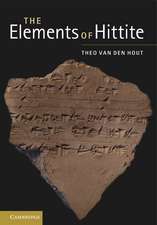Roman Artefacts and Society: Design, Behaviour, and Experience
Autor Ellen Swiften Limba Engleză Hardback – 9 feb 2017
| Toate formatele și edițiile | Preț | Express |
|---|---|---|
| Paperback (1) | 270.06 lei 31-37 zile | |
| OUP OXFORD – 25 iun 2020 | 270.06 lei 31-37 zile | |
| Hardback (1) | 849.77 lei 31-37 zile | |
| OUP OXFORD – 9 feb 2017 | 849.77 lei 31-37 zile |
Preț: 849.77 lei
Preț vechi: 1135.88 lei
-25% Nou
Puncte Express: 1275
Preț estimativ în valută:
162.65€ • 176.74$ • 136.72£
162.65€ • 176.74$ • 136.72£
Carte tipărită la comandă
Livrare economică 10-16 aprilie
Preluare comenzi: 021 569.72.76
Specificații
ISBN-13: 9780198785262
ISBN-10: 0198785267
Pagini: 320
Dimensiuni: 169 x 241 x 20 mm
Greutate: 0.68 kg
Editura: OUP OXFORD
Colecția OUP Oxford
Locul publicării:Oxford, United Kingdom
ISBN-10: 0198785267
Pagini: 320
Dimensiuni: 169 x 241 x 20 mm
Greutate: 0.68 kg
Editura: OUP OXFORD
Colecția OUP Oxford
Locul publicării:Oxford, United Kingdom
Recenzii
What Swift has produced is a unique contribution to material culture studies which provides a set of tools for thinking with and about everyday objects. It is rare to find such sensitive and nuanced theoretical discussion combined with a grounded focus on archaeological data, and Swift's book deserves to be widely read.
Offering a fresh approach to Roman material culture studies. The book explores the unexpected, social inspired twists and turns in the life of Roman objects. It leaves the reader with a good introduction to what is a detail-orientated topic. It will be of value to anyone who enjoys closely examining Roman artefacts.
the book excellently demonstrates how small finds can be brought together to offer bigger insights into Roman society.
The book is closely argued and highly technical. All items (well-illustrated in the book) have been subjected to an intense and detailed scrutiny, often involving the examination and measurement of features never previously taken into account e.g. the wear on the inside of a finger-ring. Practising craftsmen have also been consulted.
This thought-provoking book ... is better suited to advanced students and researchers with some experience in material studies ... Swift's study allows us to draw wider conclusions about the society of the northwestern Roman provinces in general, for instance by charting how artefacts can cement societal prejudice and power-relations or facilitate the performance of new behaviours, document social change, and record differences in the experience of life for people of different ages, genders and classes. As to the affordances of the book itself, the appendices are clearly set out; many artefacts are pictured, while many others (or similar representatives) can be easily found on the site of the Portable Antiquities Scheme; and I could not fault the editing.
[Roman Artefacts and Society] is an excellent and innovative piece of work, highlighting how a new emphasis on function and design can offer profound insights into ancient practices and behaviours. S. offers a nuanced discussion of continuity and change, elite and non-elite experiences and both the success and failure of cultural transmission.
Offering a fresh approach to Roman material culture studies. The book explores the unexpected, social inspired twists and turns in the life of Roman objects. It leaves the reader with a good introduction to what is a detail-orientated topic. It will be of value to anyone who enjoys closely examining Roman artefacts.
the book excellently demonstrates how small finds can be brought together to offer bigger insights into Roman society.
The book is closely argued and highly technical. All items (well-illustrated in the book) have been subjected to an intense and detailed scrutiny, often involving the examination and measurement of features never previously taken into account e.g. the wear on the inside of a finger-ring. Practising craftsmen have also been consulted.
This thought-provoking book ... is better suited to advanced students and researchers with some experience in material studies ... Swift's study allows us to draw wider conclusions about the society of the northwestern Roman provinces in general, for instance by charting how artefacts can cement societal prejudice and power-relations or facilitate the performance of new behaviours, document social change, and record differences in the experience of life for people of different ages, genders and classes. As to the affordances of the book itself, the appendices are clearly set out; many artefacts are pictured, while many others (or similar representatives) can be easily found on the site of the Portable Antiquities Scheme; and I could not fault the editing.
[Roman Artefacts and Society] is an excellent and innovative piece of work, highlighting how a new emphasis on function and design can offer profound insights into ancient practices and behaviours. S. offers a nuanced discussion of continuity and change, elite and non-elite experiences and both the success and failure of cultural transmission.
Notă biografică
Ellen Swift is Reader in Archaeology at the University of Kent. She studied archaeology at University College London where she took her B.A., M.A., and Ph.D. She has published widely on Roman artefacts, Roman and late antique art, and the late to post-Roman transition period in the West, contributing innovative approaches. She held a Leverhulme Research Fellowship in 2014-15 and is currently co-director of the University of Kent's Centre for Late Antique Archaeology. She is a Fellow of the Society of Antiquaries, and Secretary to the Roman Research Trust. Her major publications include Style and Function in Roman Decoration: Living with Objects and Interiors (2009, Ashgate).
















